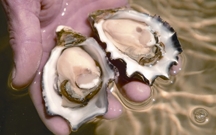Oyster
Oyster bivalve molluscs belonging to several families of the class Pelecypoda (=Bivalvia), occur in beds in shallow, warm waters of all oceans of the world.

Many of them are popularly known as pearl oyster, slipper shell, cup oyster, hammer oyster, window pane oyster, and finger oyster. The true edible oysters (Ostrea edulis and Crassostrea virginica) of the family Ostreidae have the upper valve flat, the lower concave, hinged by an elastic ligament. The mantle lying against the shell, protects the inner body, which includes respiratory, digestive and reproductive organs. The adult oyster spends its life attached to a substratum of shells, rocks, or roots. Oysters occur in appreciable numbers along the coasts of the bay of bengal and its adjacent estuaries.
In some developed and developing countries like Japan, USA, Canada, United Kingdom, China, Korea, the Philippines, and India large quantities of edible oysters are commercially exploited and harvested from natural beds. In some countries these are also cultured.
The edible oysters contain glycogen, lipids, protein, vitamins especially A, B and D and several essential minerals. Some coastal dwellers use oyster as food and fish bait. The shells are also used to make lime. [AKM Abdul Matin]
